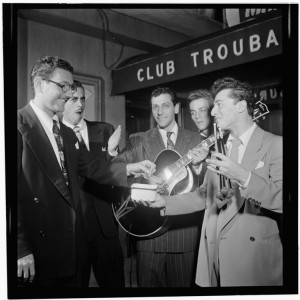3 Culture

Learning Objectives
- Differentiate between culture and society.
- Distinguish between biological and cultural explanations of human behaviour.
- Compare and contrast cultural universalism, cultural relativism, ethnocentrism, and androcentrism.
- Examine the policy of multiculturalism as a solution to the problem of diversity.
- Understand the basic elements of culture: values, beliefs, and norms.
- Explain the significance of symbols and language to a culture.
- Describe the Sapir-Whorf hypothesis.
- Distinguish material and nonmaterial culture.
3.3. Culture as Innovation: Pop Culture, Subculture, and Global Culture
- Distinguish two modes of culture: innovation and restriction.
- Discuss the distinction between high culture, pop culture, and postmodern culture.
- Differentiate between subculture and counterculture.
- Understand the role of globalization in cultural change and local lived experience.
3.4. Culture as Restriction: Rationalization and Commodification
- Describe culture as a form of restriction on social life.
- Explain the implications of rationalization and consumerism.
3.5. Theoretical Perspectives on Culture
- Discuss the major theoretical approaches to cultural interpretation.
Introduction to Culture

Are there rules for eating at McDonald’s? Usually we don’t think about rules in a fast food restaurant. But if you look around, you will see people acting as if they were trained for the role of fast food customer. They stand in line, pick their items from overhead menus before they order, swipe debit cards to pay, and stand to one side to collect trays of food. After a quick meal, customers dispose of their trash. This food system is highly organized. Customers’ movement through this fast food routine is orderly and predictable, even if no rules are posted and no officials direct the process.
Think about what would happen if you behaved according to some other standards. (You would be doing what sociologists call a “breaching experiment”: deliberately disrupting social norms to learn about them.) For example: call ahead for reservations; ask the cashier detailed questions about the food’s ingredients; barter over the price of the burgers; or throw your trash on the ground as you leave. You would get hostile responses from the restaurant employees and your fellow customers. Although the rules are not written down, you would have violated deep seated norms that govern behaviour in fast food restaurants.
What are the rules that govern what, when, and how we eat? Michael Pollan, for example, contrasts the North American culture of fast food with the traditions of eating sit-down, family meals that still dominate in France and other European nations (2006). Despite eating foods that many North Americans think of as unhealthy—butter, wheat, triple- cream cheese, wine, etc.—the French overall remain healthier and thinner than North Americans.
The French eat all sorts of supposedly unhealthy foods, but they do it according to a strict and stable set of rules: They eat small portions and don’t go back for seconds; they don’t snack; they seldom eat alone; and communal meals are long, leisurely affairs. (Pollan, 2006)

Cultural rules govern what people consider as food and how people consume food. The national cuisine and eating habits of France are oriented to pleasure and tradition, and as Pollan argues, integrated into French cultural life.
In North America, on the other hand, fast food is just a small part of a larger diet crisis.
North America sees increasing levels of obesity and eating disorders along with an increasing number of health diets, weight reducing diets, and food fads. While an alarming number of North American meals are eaten in cars (19 percent, according to Pollan), a counter-trend is an obsession with nutritional science. Instead of considering food as cultural tradition and pleasure, people think of food’s biochemical constituents (calories, proteins, carbohydrates, vitamins, omega fatty acids, saturated and unsaturated fats, etc.). There are Atkins diets, zone diets, Mediterranean diets, paleolithic diets, vegan diets, gluten free diets, Weight Watchers diets, raw food diets, etc. Pollan attributes this to fundamental anxiety about food and health among North Americans. While each type of diet claims (sometimes contradictory) scientific evidence, essentially the choice of diet revolves around the cultural meanings attributed to food:
that taste is not a true guide to what should be eaten; that one should not simply eat what one enjoys; that the important components of food cannot be seen or tasted but are discernible only in scientific laboratories; and that experimental science has produced rules of nutrition that will prevent illness and encourage longevity. (Levenstein as cited in Pollan, 2006)
In his documentary Super-Size, Me (2004), Morgan Spurlock conducted a version of the sociological participant observation study by eating only at McDonald’s for 30 days. As a result, he gained 24 pounds, increased his cholesterol and fat accumulation in his liver, and experienced mood swings and sexual dysfunction. We can’t survive on fast food alone, although many teenagers and university students have tried.

Sociologists argue that everything about food consumption habits reflects culture, the beliefs and behaviours shared by a social group. Diet is a product of culture. It is a product of the different meanings we attribute to food and to the relationship we have with our bodies. While diet is a response to the basic conditions of biological life, diet is also a site of innovation and diversity. Culture, in general, is a site of two opposing tendencies:
- cultures give sets of rules (norms) which restrict, habitualize and fix forms of life
- cultures also produce innovative and diverse solutions to problems like nutrition.
Cultures both constrain and go beyond constraints.
What’s the difference between the terms “culture” and “society”? In everyday conversation, people rarely distinguish between these terms, but culture and society have different meanings for sociologists.
- Culture refers to the beliefs, artifacts, and ways of life shared by a social group.
- A society is a group that interacts within a common territory or region.
A culture consists of beliefs, practices and material artifacts (objects) of a group; society consists of the social structures, processes, and organization of the people who share those beliefs, practices, and material artifacts. Neither society nor culture could exist without the other, but we can separate them to think about them.
This chapter examines the relationship between culture and society, paying special attention to forces that shape culture, including diversity and cultural change.
3.1. What Is Culture?
Humans are social creatures. Since Homo sapiens nearly 200,000 years ago, people have grouped together into communities to survive. Living together, people developed forms of cooperation which created the common habits, behaviours, and ways of life known as culture—from specific methods of childrearing to techniques for obtaining food. Peter Berger (1967) argued that unlike other animals, humans lack biological programming to live on their own. Humans need an extended period of dependency to survive. The creation of culture makes this possible by providing a shield against the harshness of nature. Culture provides ongoing stability for human existence. This means, however, that the human environment is not nature but culture.
First, almost every human behaviour, from shopping to marriage to expressions of feelings, is learned. In Canada, people tend to view marriage as a choice between two people based on mutual feelings of love. In other nations and in other times, marriages were arranged through a complicated process of interviews and negotiations between entire families. To someone raised in Winnipeg, the marriage customs of a family from Nigeria may seem strange or even wrong. Conversely, someone from a traditional Kolkata family think strange the idea of romantic love as foundation for the lifelong commitment of marriage. The way people view marriage depends largely on what they have been taught.

Familiarity with these written and unwritten rules of culture help people feel secure and “normal.” Most people want to live their daily lives confident that their behaviour will not be challenged. Behaviour based on learned customs is not a bad thing, but it does raise the problem of how to respond to cultural differences.
Second, culture is innovative. Different cultural practices reveal how societies find different solutions to real life problems. Different forms of marriage are solutions to a common problem, the problem of organizing families in to raise children and reproduce the species. The basic problem is shared by the different societies, but the solutions are different. Culture is a means of solving problems. Culture is a tool to coordinate complex collective actions. Culture includes creative solutions and techniques for humans to confront the shared problems of human existence. Culture is key to humans successfully adapting to the environment. Different cultures show the different means humans used to free themselves from biological and environmental limitations.
Third, culture is also restraining. Cultures retain their distinctive patterns through time. In global capitalism, Canadian culture, French culture, Malaysian culture and Kazakhstani culture share features like commodification. But these cultures also have different languages, beliefs, diet, and other ways of life. They adapt and respond to capitalism in unique ways according to their own shared heritages. Local cultural forms can restrain changes produced by globalization. On the other hand, the diversity of local cultures is increasingly limited by the pressures of globalization. Economic practices inefficient in the global market disappear. The meanings of cultural practices change as they are turned into commodities for tourists. Globalization increasingly restrains cultural forms, practices, and possibilities.
There is a cultural dynamic of innovation and restriction. Shared meanings that allow individuals to make sense of the world can change after contact with other cultures. Shared meanings can also limit change. Many contemporary issues about identity and belonging, like multiculturalism or religious fundamentalism, can be explained by this dynamic of innovation and restriction. Similarly, the effects of social change, like use of new media and response to climate change, involve tension between innovation and restriction.
Making Connections: Sociological Concepts
“Yes, but what does it mean?”

Culture is the source of shared meanings for humans. What parts of social life become visible if we focus on the social processes that produce meanings?Culture describes the meaningful collective existence. Culture refers to the shared symbols that people create to solve problems. Human social life is conducted through the meanings humans give to things, actions, others, and themselves. In a sense, people don’t live in direct contact with the world and each other; instead, they live indirectly through the shared meanings provided by culture. This mediated experience is culture. The sociology of culture is concerned with how things and actions assume meanings, how these meanings orient human behaviour, and how social life is organized around meaning.
What is the “meaning of meaning”? Max Weber (1968) notes that it is possible to imagine situations in which human experience is direct and unmediated; for example, someone taps your knee and your leg jerks forward, or you are riding your bike and get hit by a car. In these situations, experience seems purely physical, unmediated. Yet when we assimilate these experiences into our lives, we do so by making them meaningful events. By tapping your knee, the doctor is looking for signs about the functioning of your nervous system. She reads the reactions as symbolic events and assigns them meaning according to the modern biomedical understanding of the body.
While flying through the air during a car accident, you probably wouldn’t attach meaning to your position in space. Later, while talking to a friend or police officer, you tell the story of the event and attach meaning to it in your story.The meaning changes depending on the cultural context. A doctor of traditional Chinese medicine would read the knee reflex differently than a graduate of the Dal medical program. The story and meaning of the car accident changes if it is told to a friend as opposed to a police officer or an insurance adjuster.
Sociologists try to learn how events or things acquire meaning (e.g., through the reading of symptoms or the telling of stories); how the true meanings are determined (e.g., through biomedically-based diagnoses or juridical procedures of determining responsibility); and how humans interpret and share meanings (e.g., through socialization into medical, legal, insurance, and traffic systems). Sociological research into culture studies these problems of meaning.
Cultural Universals
Often, comparing one culture to another shows obvious differences. But all cultures share some common elements, too. Cultural universals are patterns common to all. The family unit is a cultural universal: Every human society has a family structure to regulate sexual reproduction and child care. How that family unit is defined, and how it functions varies. In many Asian cultures, for example, family members from all generations often live together in one household. In these cultures, young adults continue to live in the extended family until they marry and join their spouse’s household. They may remain and raise their offspring within the extended family’s home. In Canada, by contrast, individuals are expected to leave home and live independently for a period before forming a family unit.
Cultural universals often involve basic human survival, such as finding food, clothing, and shelter. They often involve shared human experiences, such as birth and death, or illness and healing. Other universals include language, the concept of personal names, and jokes. Humour is a universal way to release tension and create a unity among people (Murdock, 1949). Sociologists consider humour necessary to human interaction because it helps individuals navigate otherwise tense situations.
Making Connections: Sociological Research
Is Music a Cultural Universal?

Imagine that you are sitting in a theatre, watching a film. The movie opens with the hero sitting on a park bench with a grim expression on her face. Cue the music. The first slow and mournful notes are played in a minor key. As the melody continues, the hero turns her head and sees a man walking toward her. The music slowly gets louder, and the dissonance of the chords sends a prickle of fear running down your spine. You sense that she is in danger.
Now imagine that you are watching the same movie, but with a different soundtrack. As the scene opens, the music is soft and soothing with a hint of sadness. You see the hero sitting on the park bench and sense her loneliness. Suddenly, the music swells. The woman looks up and sees a man walking toward her. The music grows fuller, and the pace picks up. You feel your heart rise in your chest. This is a happy moment.
Music can evoke emotional responses. In television shows, movies, and even commercials, music elicits laughter, sadness, or fear. Are these types of musical cues cultural universals?
In 2009, a team of psychologists, led by Thomas Fritz of the Max Planck Institute for Human Cognitive and Brain Sciences in Leipzig, Germany, studied people’s reactions to music they’d never heard (Fritz et al., 2009). The research team travelled to Cameroon, Africa, and asked Mafa tribal members to listen to Western music. The tribe, isolated from Western culture, had never been exposed to Western culture and had no context or experience within which to interpret its music. Even so, as the tribal members listened to a Western piano piece, they were able to recognize three basic emotions: happiness, sadness, and fear. Music, it turns out, is a sort of universal language.
Researchers also found that music can foster a sense of wholeness within a group. Additionally, since music is largely nonverbal, the sounds of music can cross societal boundaries more easily than words. Music allows people to make connections where language might create obstacles. As Fritz and his team found, music and the emotions it conveys can be cultural universals.
Ethnocentrism and Cultural Relativism
Despite how much humans have in common, cultural differences are more common than cultural universals. For example, while all cultures have language, languages and conversation rules can be very different. In some Middle Eastern cultures, it is common to stand close to others in conversation. North Americans keep more distance, maintaining a larger personal space. Even something as simple as eating and drinking varies greatly from culture to culture. If your instructor comes into an early morning class holding a mug of liquid, what do you assume she is drinking? In Canada, it’s most likely filled with coffee, not Earl Grey tea, a favourite in England, or yak butter tea, a staple in Tibet.
Some travelers enjoy trying unfamiliar foods. Others return home rejoicing in their own culture’s food. Canadians might express disgust at other cultures’ cuisine, thinking it gross to eat meat from a dog or guinea pig for example, while they do not question their own habit of eating cows or pigs. Such attitudes are an example of ethnocentrism or evaluating and judging another culture based on how it compares to one’s own culture. Ethnocentrism involves believing that one’s own culture is better than all others (Sumner, 1906). Almost everyone is a little bit ethnocentric. For example, Canadians tend to say that people from England drive on the “wrong” side of the road, rather than the “other” side. Someone from a country where dogs are considered dirty might find it disgusting to see a helper dog in a restaurant.
Appreciating one’s own culture can be healthy; a shared sense of community pride, for example, connects people in a society. But ethnocentrism can lead to disrespect for other cultures, causing misunderstanding and conflict. People with good intentions sometimes travel to a society to “help” its people, seeing them as uneducated or backward, essentially inferior. These travellers are guilty of cultural imperialism — the deliberate imposition of one’s own cultural values on another culture. Europe’s colonial expansion, begun in the 16th century, included severe cultural imperialism. European colonizers often viewed the people in the lands they colonized as uncultured “savages” in need of European governance, dress, religion, and other cultural practices. Canada’s residential school system shows how serious the consequences of ethnocentrism can be. Another example of cultural imperialism includes some work of international aid agencies. For example, these agencies sometimes introduced “modern” technological agricultural methods and plant species from developed countries but overlooked indigenous varieties and agricultural approaches better suited to the region.
Ethnocentrism can be so strong when people meet a new culture, they experience disorientation and frustration or culture shock. A traveller from Toronto might find the nightly silence of rural Alberta unsettling, not peaceful. An exchange student from China might be annoyed by the constant interruptions in class as other students ask questions—a practice that is considered rude in China. Perhaps the Toronto traveller was initially captivated with Alberta’s quiet beauty, and the Chinese student was originally excited to see an Canadian-style classroom firsthand. But as they experience unanticipated differences from their own culture, their excitement gives way to discomfort and doubts about how to behave appropriately in the new situation. Eventually, as people learn more about a culture, they recover from culture shock.
Cultural relativism is the practice of assessing a culture by its own standards rather than viewing it through the lens of one’s own culture. Many sociologists argue that each culture has an internally consistent pattern of thought and action, which alone could be the basis for judging the merits and morality of the culture’s practices. Cultural relativism requires an open mind.
Cultural relativism is the basis of multiculturalism. However, embracing everything about a new culture is not always possible. Even the most culturally relativist people from egalitarian societies, such as Canada— societies in which women have political rights and control over their own bodies— would question whether the practice of female circumcision in countries such as Ethiopia and Sudan should be accepted as a part of a cultural tradition.
Cultural pride does not have to lead to imposing values on others. Appreciation for another culture does not prevent sociologists from studying it critically. In the case of female circumcision, for example, a universal right to life and liberty conflicts with the neutral stance of cultural relativism. It is not ethnocentric to be critical of practices that violate universal standards of human dignity. All cultures have universal standards of human dignity, though they may not be followed in practice. Not every practice can be regarded as culturally relative. Cultural traditions can develop from power imbalances. Liberation movements seek to correct them.
Feminist sociology studies the way that most cultures present a male-dominated view of the world. Androcentricism is a perspective in which male concerns, male attitudes, and male practices are presented as “normal” or define what is valued in a culture. Women’s experiences, activities, and contributions to society and history are ignored, devalued, or marginalized.
It is still common, for example, to read writing that uses the personal pronoun “he” or the word “man” to represent people in general or humanity. The overall effect is to establish masculine values and imagery as normal. A “policeman” suggests a man who is doing a “man’s job”, when in fact women have been involved in policing for several decades now.
Making Connections: Social Policy and Debate
Multiculturalism in Canada

(Photo courtesy of constancemc/Flickr)
One important aspect of Canadian cultural identity is multiculturalism. Canada was the first officially multicultural society. Prime Minister Pierre Trudeau declared in 1971 that no culture would take precedence over any other.
Multiculturalism refers to both the diversity of cultures and to a way of thinking about and managing cultural diversity. Multiculturalism seeks to both promote and recognize cultural differences while addressing cultural tensions. In the 1988 Multiculturalism Act, the federal government officially acknowledged its role “in bringing about equal access and participation for all Canadians in the economic, social, cultural, and political life of the nation” (Government of Canada, as cited in Angelini & Broderick, 2012).
However, multiculturalism has not always been so central to Canadian public discourse. Multiculturalism represents a relatively recent cultural development. Before World War II, Canadian authorities used the unscientific concept of biological race to differentiate the types of immigrants and Indigenous peoples in Canada. This led to fears about immigrant “stock” and the problems of how to manage the mixture of races. Three different models for managing diversity emerged: (1) the American “melting pot” paradigm in which the mingling of races was thought to be able to produce a super race with the best qualities of all races combined, (2) strict exclusion or deportation of races seen to be “unsuited” to Canadian social and environmental conditions, or (3) the Canadian “mosaic”, separation and compartmentalization of races (Day, 2000).
After World War II, the category of race was replaced by culture and ethnicity in public debate, but the mosaic model remained. New definitions of culture as a deep-seated emotional-psychological phenomenon emerged. In this view, to be deprived of culture through coercive assimilation would be cultural genocide. As a result, alternatives to cultural assimilation into the dominant Anglo-Saxon culture were debated, and the Canadian mosaic model was redefined as multiculturalism. Based on a new appreciation of culture, and with increased immigration from non-European countries, Canadian identity was re-imagined in the 1960s and 1970s as a happy cohabitation of cultures, with each encouraged to maintain cultural distinctiveness. So while the cultural identity of Canadians is diverse, multiculturalism has come to represent Canadian cultural identity.
However, problems of cultural difference persist. Multicultural policy sparked numerous controversies, from whether Sikh RCMP officers can wear turbans to whether Mormon sects can have legal polygamous marriages.
Critics of multiculturalism identify four related problems:
- Multiculturalism only superficially accepts the equality of all cultures while continuing to limit and prohibit actual equality, participation, and cultural expression. One key element of this criticism is that there are only two official languages in Canada — English and French — which limits the full participation of non-anglophone/francophone groups.
- Multiculturalism obliges minority individuals to assume the limited cultural identities of their ethnic group of origin, which leads to stereotyping minority groups, ghettoization, and feeling isolated from the national culture.
- Multiculturalism causes fragmentation and disunity in Canadian society. Minorities do not integrate into existing Canadian society but demand that Canadians adopt or accommodate their way of life, even when they espouse controversial values, laws, and customs (like polygamy or sharia law).
- Multiculturalism is based on recognizing group rights which undermines constitutional protections of individual rights.
On the other hand, proponents of multiculturalism like Will Kymlicka describe the Canadian experience with multiculturalism as a success story. Kymlicka argues that the evidence shows:
“Immigrants in Canada are more likely to become citizens, to vote and to run for office, and to be elected to office than immigrants in other Western democracies, in part because voters in Canada do not discriminate against such candidates. Compared to their counterparts in other Western democracies, the children of immigrants have better educational outcomes, and while immigrants in all Western societies suffer from an “ethnic penalty” in translating their skills into jobs, the size of this ethnic penalty is lowest in Canada. Compared to residents of other Western democracies, Canadians are more likely to say that immigration is beneficial and less likely to have prejudiced views of Muslims. And whereas ethnic diversity has been shown to erode levels of trust and social capital in other countries, there appears to be a “Canadian exceptionalism” in this regard.”(2012)
3.2. Elements of Culture
Values and Beliefs
Values and beliefs are two important elements of culture. Values are a culture’s standard for what is true, good, just, or beautiful. Values are deeply embedded and important for transmitting and teaching a culture’s beliefs. Beliefs are the convictions people hold to be true. Individuals in a society believe certain things to be true, and they also share collective values. For example, North Americans often believe that anyone who works hard enough will be successful and wealthy. Underlying this belief is the value that wealth is good and desirable.
Values help shape a society by suggesting what is good and bad, beautiful and ugly, and what should be sought or avoided. Consider the value that North American culture places on youth. Children represent innocence and purity, while a youthful adult appearance signifies sexuality. Shaped by this value, North Americans spend millions of dollars each year on cosmetic products and surgeries to look young and beautiful.
Sometimes the values of Canada and the United States are contrasted. Americans are said to have an individualistic culture, meaning people place a high value on individuality and independence. In contrast, Canadian culture is said to be more collectivist, meaning the welfare of the group and group relationships are primary values.
Living up to a culture’s values can be difficult. It’s easy to value good health, but it’s hard to quit smoking. Marital monogamy is valued, but many spouses are unfaithful. Cultural diversity and equal opportunities for all are valued in Canada, but the country’s highest political offices have been dominated by white men.
Values often suggest how people should behave, but values often don’t reflect how people actually behave. Values portray an ideal culture, the standards society would like to embrace and live up to. But ideal culture differs from real culture, the way society really is.
In an ideal culture, there would be no traffic accidents, murders, poverty, or ethnic tension. But in real culture, police officers, lawmakers, educators, and social workers constantly strive to prevent or repair those accidents, crimes, and injustices. Teenagers are encouraged to value celibacy. However, the number of unplanned teen pregnancies shows that not only is the ideal hard to live up to, but that the value alone is not enough to spare teenagers from the potential consequences of having sex.
Societies try to put values into action through rewards, sanctions, and punishments. When people observe the norms of society and uphold its values, they are often rewarded. A boy who helps an elderly woman board a bus may receive a smile and a “thank you.” A business manager who raises profit margins may receive a quarterly bonus. People sanction certain behaviours by giving their support, approval, or permission, or by giving formal disapproval and non-support. Sanctions are a form of social control, a way to encourage conformity to cultural norms. Sometimes people conform to norms in anticipation or expectation of positive sanctions: Good grades, for instance, may mean praise from parents and teachers.
When people go against a society’s values, they are punished. A boy who shoves an elderly woman aside to board the bus first may receive frowns or even a scolding from other passengers. A business manager who drives away customers will likely be fired. Breaking norms and rejecting values can lead to cultural sanctions such as earning a negative label— lazy, no-good bum —or to legal sanctions such as traffic tickets, fines, or imprisonment.
Values vary across time and between groups as people evaluate, debate, and change collective societal beliefs. Values also vary from culture to culture. For example, cultures differ in their values about what kinds of physical closeness are appropriate in public. It is rare to see two male friends or coworkers holding hands in Canada where that behaviour often symbolizes romantic feelings. But in many nations, masculine physical intimacy is considered natural in public. A simple gesture, such as hand-holding, carries great symbolic differences across cultures.
Norms

The examples in this chapter have often described how people are expected to behave in certain situations— for example, when buying food or boarding a bus. These examples describe the visible and invisible rules of conduct through which societies are structured. Sociologists call these rules norms. While values and beliefs identify desirable states and convictions, a norm is a generally accepted way of doing things. Norms define how to behave according to what a society has defined as good, right, and important. Most members of the society respect norms because violation involves some degree of sanction. Norms define the rules that govern behaviour.
Formal norms are established, written rules. They are behaviours worked out and agreed upon to serve most people. Laws are formal norms, but so are employee manuals, college entrance requirements, and regulations such as “no running at swimming pools”. Formal norms are the most specific and clearly stated of the various types of norms, and the most strictly enforced. But even enforcement of formal norms reflects cultural values.
For example, money is highly valued in North America, so monetary crimes are punished. It is against the law to rob a bank, and banks go to great lengths to prevent such crimes. People guard valuable possessions and install anti-theft devices to protect homes and cars. Until recently, a less strictly enforced social norm was driving while intoxicated. Though there have been laws in Canada to punish drunk driving since 1921, there were few systems in place to prevent the crime until quite recently. These examples show a range of enforcement in formal norms.
While there are many formal norms, there are even more informal norms. Informal norms are casual behaviours that are generally conformed to. People learn informal norms by observation, imitation, and general socialization. Some informal norms are taught directly: “kiss your Aunt Edna” or “use your napkin.” Other informal norms are learned by observation, including observations of consequences when someone else violates a norm. Children learn quickly that picking your nose is subject to ridicule when they see someone shamed for it by other children.
Although informal norms define personal interactions, they extend into larger systems tool. Think back to the discussion of fast food restaurants at the beginning of this chapter. In Canada, there are informal norms about behaviour at these restaurants. Customers line up to order their food and leave when they are done. They do not sit down at a table with strangers, sing loudly as they prepare their condiments, or nap in a booth. Most people do not commit even benign breaches of informal norms. Informal norms dictate appropriate behaviours without the need of written rules.
Making Connections: Sociological Research
Breaching Experiments

Sociologist Harold Garfinkel studied people’s customs to learn how often unconscious and norms influence behaviour and enabled the social order to exist (Weber, 2011). Like the symbolic interactionists, he believed that people together create a social order. He noted, however, that people often draw on unspoken agreements to do so. He discusses the underlying assumptions people use to create “accounts” or stories to let them make sense of the world.
One of his research methods was known as a breaching experiment. His breaching experiments tested sociological ideas about norms and conformity. In a breaching experiment, the researcher purposely breaks a social norm. The participants are not aware an experiment is in progress.
If the breach is successful, however, these innocent bystanders will respond in some way. For example, he had his students go into shops and barter with the sales clerks: “This says $14.99, but I’ll give you $10 for it.” Often the clerks were shocked or flustered. This breach reveals the unspoken convention in North America that the amount given on the price tag is the price. It also breaks other conventions which seek to make commercial transactions as efficient and impersonal as possible.
In another example, he had his students respond to the casual greeting, “How are you?” with a detailed description of their state of health and well-being. The point of
the experiments was not that the experimenter would simply act obnoxiously or weird in public. Rather, the point is to deviate from a social norm in a small way to and see what happens.
Garfinkel deliberately imposed strange behaviours on unknowing people. Then he would observe their responses.
There are many rules about speaking with strangers in public. It is okay to tell a woman you like her shoes. It is not okay to ask if you can try them on. It is okay to stand in line behind someone at the ATM. It is not okay to look over their shoulder as they make the transaction. It is okay to sit beside someone on a crowded bus. It is “weird” to sit beside a stranger in a half-empty bus.
For some breaches, the researcher directly engaged with innocent bystanders. An experimenter might strike up a conversation in a public bathroom, where it’s common to respect each other’s privacy so much that we can ignore another’s presence. In a grocery store, an experimenter might take a food item out of another person’s grocery cart, saying, “That looks good! I think I’ll try it.” An experimenter might sit down at a table with others in a fast food restaurant, or follow someone around a museum, studying the same paintings. In those cases, the bystanders are pressured to respond, and their discomfort illustrates how much we depend on social norms.
These cultural norms play an important role. They let us know how to behave around each other and how to feel comfortable in our community, but they are not necessarily rational. Why should we not talk to someone in a public bathroom, or haggle over the price of a good in a store? Breaching experiments uncover and explore the many unwritten social rules we live by. They indicate the degree to which the world we live in is fragile, arbitrary and ritualistic; socially structured by deep, silent agreements with others. Frequently we are not really aware of them.
Symbols and Language

Humans, consciously and subconsciously, are always trying to make sense of their surrounding world. Symbols—such as gestures, signs, objects, signals, and words —stand in for or represent something else. Symbols provide clues to understanding the underlying experiences, statuses, states, and ideas they express. They convey recognizable meanings shared by societies.
The world is filled with symbols. Sports uniforms, company logos and traffic signs are symbols. In some cultures, a gold ring is a symbol of marriage. Some symbols are highly functional: stop signs, for instance, provide useful instruction. As physical objects they belong to material culture, but because they function as symbols, they also convey nonmaterial cultural meanings. Some symbols are only valuable in what they represent. Trophies, blue ribbons, or gold medals, for example, serve no purpose other than to represent accomplishments. Many objects have both material and nonmaterial symbolic value.
A police officer’s badge and uniform are symbols of authority and law enforcement. The sight of a police officer in uniform or in a police car triggers reassurance in some citizens but annoyance, fear, or anger in others.
Symbols are often noticed when they are used out of context. Used unconventionally, symbols can send strong messages. A stop sign on the door of a corporation makes a political statement. A camouflage military jacket worn in an antiwar protest makes a statement. Internet memes—images that spread from person to person through reposting—often adopt these tactics for fun or as a political statement. An image of former Prime Minister Stephen Harper in a folksy sweater holding a cute cat was altered to show him holding an oily duck instead: this was a detournement with a political message.
Even the destruction of symbols is symbolic. Effigies representing public figures are burned to demonstrate anger at certain leaders. In 1989, crowds tore down the Berlin Wall, a decades-old symbol of the division between East and West Germany, or between communism and capitalism.
While different cultures have varying systems of symbols, there is one that is common to all: the use of language. Language is a symbolic system through which people communicate and through which culture is transmitted. Some languages contain a system of symbols used for written communication, while others rely only on spoken communication and nonverbal actions.
Rules for speaking and writing vary even within cultures, often by region. Do you refer to a can of carbonated liquid as a soda, pop, or soft drink? Is a household entertainment room a family room, rec room, or den? When leaving a restaurant, do you ask your server for the cheque or the bill?
Language constantly evolves as societies create new ideas. With technology, people adapt almost instantly to new nouns such as email and internet, and verbs such as download, text, and blog. Thirty years ago, the general public would have considered these nonsense words.
Material and Nonmaterial Culture
Even an action as simple as getting to work contains a great deal of cultural meaning. Think about using public transportation. Whether commuting in Dublin, Cairo, Mumbai, or Vancouver, many behaviours will be the same in all locations, but there will also be significant differences. Typically, in Canada, a passenger finds a marked bus stop or station, waits for the bus or train, pays an agent before or after boarding, and quietly takes a seat if one is available. But when boarding a bus in Cairo, passengers might need to run, because buses often do not come to a full stop to take on patrons. Dublin bus riders are expected to extend an arm to indicate that they want the bus to stop. When boarding a commuter train in Mumbai, passengers must squeeze into overstuffed cars with a lot of pushing and shoving on the crowded platforms. That kind of behaviour would be considered the very rude in Canada, but in Mumbai it reflects the daily challenges of getting around on an overcrowded train system.
The commuting example shows different cultural responses to a common problem, the problem of public transportation. The problem is shared, but the solutions are different. Cultural solutions consist of two components: thoughts (expectations about personal space, for example) and tangible things (bus stops, trains, and seating capacity). Culture includes both material and non-material elements. Material culture refers to the artifacts, technologies, and products of a group of people. Bus passes and bus tickets are part of material culture. Automobiles, stores, and the physical structures where people worship are part of material culture. Nonmaterial culture, in contrast, consists of knowledge and beliefs, forms of communication, and norms of behaviour of a society. Cultures use both material and nonmaterial components to adapt and respond to the tasks of life.
Material and nonmaterial aspects of culture are linked, and physical objects often symbolize cultural ideas. A bus pass is a material object, but it represents part of nonmaterial culture, capitalism, and the acceptance of paying for transportation. Clothing, hairstyles, and jewelry are part of material culture, but the appropriateness of wearing certain clothing for specific events reflects nonmaterial culture. A school building belongs to material culture, but the teaching methods and educational standards are part of education’s nonmaterial culture. These material and nonmaterial aspects of culture can vary subtly from region to region.
As people travel farther, moving from different regions to entirely different parts of the world, some material and nonmaterial aspects of culture become dramatically unfamiliar. We notice this when we encounter different cultures. As we interact with cultures other than our own, we become more aware of the differences and commonalities between others’ worlds and our own.
3.3. Culture as Innovation: Pop Culture, Subculture, Global Culture

Culture is the source of the shared meanings through which we interpret the world. While cultural practices are in some ways a response to biology or economy, they are not totally determined by these factors. Culture is innovative; it expresses the human imagination to solve problems, to produce innovations — new objects, ideas, or ways of being. At the same time, we are born into cultures that shape us: Languages, ways of thinking, ways of doing things, and artifacts we inherit and fit ourselves into. Culture can, therefore, also be restrictive, imposing forms of life, beliefs, and practices on people, and limiting the possibilities of what we can think and do.
The next two sections of this chapter examine aspects of culture which are innovative–high culture and popular culture, subculture, and global culture — and aspects of culture which are restrictive — rationalization and consumerism.
High Culture and Popular Culture
Do you prefer listening to opera or hip-hop music? Do you like watching horse jumping or NASCAR? Do you read books of poetry or magazines about celebrities?
Sociologists use the term high culture to describe cultural experience characterized by formal complexity, eternal values, or intrinsic authenticity such as is provided by the Greek classics, Beethoven’s symphonies, Sergei Diaghilev’s ballets, or James Joyce’s Ulysses. People often associate high culture with intellectualism, elitism, wealth, and prestige. Pierre Bourdieu (1984) argues high culture is not only a symbol of distinction, but a means of maintaining status and power distinctions through the transfer of cultural capital: the knowledge, skills, tastes, mannerisms, speaking style, posture, material possessions, credentials, etc. that a person acquires from family background. Events considered high culture can be expensive and formal — attending a ballet, seeing a play, or listening to a live symphony performance — and the people who appreciate these events are often those who have enjoyed the benefits of an enriched and exclusive cultural background.
The term popular culture refers to the pattern of cultural experiences and attitudes that exist in mainstream society: cultural experiences well-liked by “the people.” Popular culture events might include a parade, a baseball game, or a rock concert. Rock and pop music — “pop” is short for “popular” — are part of popular culture. Popular culture is often expressed and spread by commercial media such as radio, television, movies, the music industry, publishers, and corporate-run websites. Unlike high culture, popular culture is accessible to most people. You can share a discussion of favourite hockey teams with a new coworker, or comment on the TV show Game of Thrones when making small talk at the grocery store. But if you tried to launch into a deep discussion on the classical Greek play Antigone, few members of Canadian society would be familiar.
The labels of high culture and popular culture vary over time and place. Shakespearean plays, considered pop culture when they were written, are now among Western society’s high culture. Television programming has gone from typical low brow situation comedies, soap operas, and crime dramas to the development of series with increasingly sophisticated characters, narratives, and themes (e.g., The Sopranos, True Blood, Dexter, Breaking Bad, Mad Men, and Game of Thrones).
Contemporary popular culture is frequently referred to as a postmodern culture. In postmodern culture — the form of culture that came after modern culture — it’s more common to find various sorts of mash-ups of high and low: Serious literature combined with zombie themes; pop music constructed from recycled samples; symphony orchestras performing the soundtracks of cartoons; architecture that playfully borrows and blends historical styles; etc. Rock music is the subject of many highbrow histories and academic analyses, just as the common objects of popular culture are transformed and represented as high art. Andy Warhol’s Campbell’s Soup Cans are one example. Postmodern popular culture is both playful and ironic, as if the blending and mixing of cultural references, like in the television show The Simpsons, is one big in-joke. recycles and remixes elements of previous cultural production.
In postmodern culture, everyone with computer access and editing software can be a cultural producer: Everyone has an important voice. Access to knowledge is simply a matter of crowd-sourcing.
Postmoderns no longer really believe in the big stories (metanarratives) and social projects of modernity. Postmoderns are skeptical of the claims that scientific knowledge leads to progress, that political change creates human emancipation, that Truth sets us free. Some see this erosion of authority and decline in consensus around core values as a relativism of values. In relativism, no standard exists to judge one thing more significant than another. Everyone will make up their own little stories, each as valid as the next, as we see when creationists seek to debunk the “myths” of evolutionary theory, for example. Others argue that the outcome leads to a necessary critique of the unexamined assumptions of power and authority in modern culture– for example, the rhetoric of “family values” or “scientific progress” lampooned in The Simpsons. Instead of the privileged truths of elites and authorities, postmodernity features a plurality of different voices that had been kept at the margins. Culture moves away from homogeneous sameness to heterogeneous diversity.
Subculture and Counterculture
A subculture is just as it sounds—a smaller cultural group within a larger culture. People of a subculture are part of the larger culture, but also share an identity in a smaller group. Thousands of subcultures exist in Canada. Ethnic groups share the language, food, and customs of their heritage. Other subcultures are defined by shared experiences. For example, biker culture revolves around a dedication to motorcycles. Some subcultures are formed by members who possess traits or preferences that differ from the majority of a society’s population. Alcoholics Anonymous offers support to those suffering from alcoholism. The body modification community embraces tattoos, piercings, and certain forms of plastic surgery. But although members of a subculture form around a distinct identity, they still identify with and participate in the larger society.
Sociologists distinguish subcultures from countercultures. Countercultures are a type of subculture that rejects the larger culture’s norms and values. In contrast to subcultures, which operate within the larger society, countercultures might actively defy larger society by developing their own set of rules and norms. Sometimes countercultures even create communities that operate outside of greater society.
The period after World War II saw a series of “spectacular” youth cultures — teddy boys, beatniks, mods, hippies, bikers, skinheads, rastas, punks, new wavers, ravers, hip-hoppers, and hipsters — who in various ways sought to reject the values of their parents’ generation. The hippies, for example, were a subculture that became a counterculture They blended protest against the Vietnam War, technocracy and consumer culture with a back to the land movement, non-Western forms of spirituality, and the practice of voluntary simplicity. Counterculture, in this example, refers to the cultural forms of life taken by a political and social protest movement.
Cults are also considered countercultural groups. They are usually informal, transient religious groups that deviate from orthodox beliefs. Cults often involve intense emotional commitment to the group and allegiance to a charismatic leader.
However, sometimes the dominant society judges a cult’s challenge to laws and norms as going too. For example, the group Yearning for Zion (YFZ) in Eldorado, Texas existed quietly until its leader was accused of statutory rape and underage marriage. The sect’s formal norms clashed too severely to be tolerated by U.S. law. In 2008 authorities raided the compound, removing more than 200 women and children from the property.

How much countercultures reject the larger culture is sometimes questionable, however. Phil Cohen (1972) analyzed British working-class youth subcultures like the teddy boys, mods, and skinheads. He noted that the style and concerns of the groups could be a “compromise solution between two contradictory needs: the need to create and express autonomy and difference from parents…and the need to maintain parental identifications” (as cited in Hebdige, 1979).
In the 1960s and 70s, for example, skinheads shaved their heads, listened to ska music from Jamaica, participated in racist chants at soccer games, and wore highly polished Doc Marten boots in a manner that deliberately alienated their parents while expressing their own alienation as working-class youth with few job prospects in deindustrialized England. At the same time their subcultural outfit was a “caricature of the model worker” their parents aspired to. Their attitudes simply exaggerated the proletarian, puritanical, and chauvinist traits of their parents’ generation. On one hand the invention of skinhead culture was an innovative cultural creation; on the other hand, it just exaggerated the already existing contradictions of the skinheads’ class situation and that of their parents.
Making Connections: Sociology in the Real World
The Evolution of North American Hipster Subculture
Skinny jeans, chunky glasses, ironic moustaches, retro-style single speed bicycles and T-shirts with vintage logos—the hipster is a recognizable figure in contemporary North American culture. Mostly found in metropolitan areas, hipsters seek to define themselves by a rejection of mainstream norms and fashion styles. As a subculture, hipsters reject many values and beliefs of North American society, tending to prefer a bohemian lifestyle over one defined by the accumulation of power and wealth. At the same time they are very concerned with the pedigree of the music, styles, and objects that identify them.
When did hipster subculture begin? While commonly viewed as a recent trend among middle-class youth, the history of the group stretches back to the early decades of the 1900s.

In the 1940s, black American jazz music was on the rise in the United States. Musicians were known as hepcats and had a smooth, relaxed style that contrasted with more conservative and mainstream expressions of cultural taste. Norman Mailer (1923 – 2007), in his essay The White Negro: Superficial Reflections on the Hipster (1957), defined those who were “hep” or “hip” as largely white youth living by a black jazz-inspired code of resistance, while those who were “square” lived according to society’s rules and conventions.
As hipster attitudes spread and young people were increasingly drawn to alternative music and fashion, attitudes and language derived from the culture of jazz were adopted. Hipster slang was purposefully ambiguous. When hipsters said, “It’s cool, man,” they meant not that everything was good, but that it was the way it was.
By the 1950s, another variation on the subculture emerged. Quebecois-American writer Jack Kerouac (1922 – 1969) called it the beat generation. Beats were defined as a generation that was nonconformist and anti-materialistic. Prominent in this movement were writers and poets who listened to jazz, studied Eastern religions, experimented with different states of experience, and embraced radical politics of personal liberation. They bummed around, hitchhiked the country and lived marginally. While the beat was focused on inner experience, the hipster was focused on the external style.
By the end of the 1950s, the influence diminished and many traits of hepcat culture became mainstream. College students, questioning the relevance of the American dream after Word War II, clutched copies of Kerouac’s On the Road, dressed in berets, black turtlenecks, and black-rimmed glasses. Women wore black leotards and grew their hair long. The subculture became visible and was covered in Life magazine, Esquire, Playboy, and other mainstream media.

Herb Caen (1916 – 1997), a San Francisco journalist, used the suffix from Sputnik 1, the Russian satellite that orbited Earth in 1957, to dub the movement’s followers as “beatniks.” They were subsequently lampooned as lazy in television shows like The Many Loves of Dobie Gillis (1959 – 1963) or dangerous, drug-abusing delinquents in movies like High School Confidential (1958).As the beat generation faded, a new related movement began. It too focused on breaking social boundaries, but also advocated freedom of expression, philosophy, and love. It took its name from the generations before; in fact, some theorists claim that the beats themselves coined the term to describe their children. Over time, the “little hipsters” of the 1960s and 70s became known simply as hippies. Others think that hippie was a derogatory label invented by the mainstream press to discredit and stereotype the movement and its non-materialist aspirations.Contemporary expressions of the hipster rose out of the hippie movement in the same way that hippies evolved from the beats and beats from hepcats. Although today’s hipster may not seem to have much in common with the jazz-inspired youth of the 1940s, or the long-haired back to the land movement of the 1960s, an emphasis on nonconformity persists. Sociologist Mark Greif investigated the hipster subculture of the United States and found that much of what tied the group together was not a specific set of fashion or music choices, nor a specific point of contention with the mainstream. What has emerged, rather, is an appropriation of consumer capitalism that seeks authenticity.In his New York Times article “The Hipster in the Mirror” Greif wrote, “All hipsters play at being the inventors or first adopters of novelties: pride comes from knowing, and deciding, what’s cool in advance of the rest of the world” (2010). What tends to be cool is an ironic pastiche of borrowed styles or tastes that signify other identities or histories: alternative music (sometimes very obscure), used vintage clothing, organic and artisanal foods and products, single gear bikes, and countercultural values and lifestyles.Young people are often drawn to oppose mainstream conventions. Much as the hepcats of the jazz era opposed common culture with carefully crafted appearances of coolness and relaxation, modern hipsters reject mainstream values with a purposeful apathy. Ironic, cool to the point of non-caring, and intellectual, hipsters continue to embody a subculture while simultaneously impacting mainstream culture.
Global Culture
Beginning in the 1970s, Western governments began to deregulate social services while granting greater freedom to private businesses. World markets became dominated by unregulated, international capital and new multinational corporations. A global economy replaced nationally based economies. We refer to this integration of international trade and finance as globalization.
Global communications and air travel also increase the international flow not only of goods but also of information and people (Scheuerman, 2010). Today, many Canadian companies set up offices in other nations where the costs of resources and labour are cheaper. When a person in Canada calls to get information about banking, insurance, or computer services, the person taking that call may be working in India or Indonesia.
With globalization is diffusion, the spread of material and nonmaterial culture. While globalization refers to the integration of markets, diffusion refers to the integration of cultures. Middle-class North Americans can fly overseas and return with a new appreciation of Thai noodles or Italian gelato. Access to television and the internet has brought the lifestyles and values portrayed in Hollywood sitcoms the globe. Twitter feeds from public demonstrations in one nation have encouraged political protesters in other countries. When this kind of diffusion occurs, material objects and ideas from one culture are introduced into another.
Global migration also facilitates cultural diffusion. Ideas and artifacts spread out as people move from their original homeland. As Arjun Appadurai (1996) suggests, “More people than ever before seem to imagine the possibility that they or their children will live and work in places other than where they were born: this is the wellspring of the increased rates of migration at every level of social, national, and global life.” This likelihood of movement, whether actual or imagined, changes the cultural coordinates of how people see themselves in the world.
All migrants, refugees, temporary foreign workers, or travellers bring their beliefs, attitudes, languages, cuisines, music, religious practices when they move, and they meet new cultures where they arrive. Electronic media allows global migrants and travellers to keep in touch with friends, family and culture from home. Electronic media also give migrants access to the culture of their new homes. Media allows people to imagine future homes elsewhere in the world. With globalization, culture is increasingly separated from location. The ways people imagine themselves and define their attachments, interests, and aspirations dissolve the divisions between cultures formerly set by national boundaries.
Culture has two opposing tendencies: One is the way that cultures around the world set norms which constrain, restrict, habitualize and fix forms of life; the other is the way that cultures produce innovative and diverse solutions to problems like nutrition. Cultures both constrain and continually go beyond constraints.
Chapter Summary
What Is Culture?
“Society” and “culture” have different meanings in sociology. A society is a group of people sharing a community and culture. Culture describes the shared behaviours and beliefs of these people, and includes material and nonmaterial elements. Our experience of cultural difference is influenced by our ethnocentrism.
Elements of Culture
A culture consists of many elements, including values and beliefs. Culture is also governed by norms, including laws. The symbols and language of a society develop and transmit culture.
Pop Culture, Subculture, and Cultural Change
Sociologists recognize high culture and popular culture. Societies also have many subcultures—smaller groups that share an identity. Countercultures reject mainstream values and create their own cultural rules and norms. Through invention or discovery, cultures evolve with new ideas and ways of thinking. Technology is also responsible for the spread of both material and nonmaterial culture and contributes to globalization.
Key Terms
beliefs: convictions that people hold to be true.
counterculture: A group that rejects and opposes society’s widely accepted cultural patterns.
cultural imperialism: The deliberate imposition of one’s own cultural values on another culture.
cultural relativism: The practice of assessing a culture by its own standards, and not in comparison to another culture.
cultural universals: Patterns or traits that are globally common to all societies.
culture: Shared beliefs, values, and practices.
culture shock: An experience of personal disorientation when confronted with an unfamiliar way of life.
diffusion: The spread of material and nonmaterial culture from one culture to another.
ethnocentrism: Evaluating another culture according to the standards of one’s own culture.
formal norms: Established, written rules for behaviour, from codes of conduct to laws.
globalization: The integration of international trade and finance markets.
high culture: Forms of cultural experience characterized by formal complexity, eternal values, or intrinsic authenticity.
ideal culture: The standards a society would like to embrace and live up to.
informal norms: Casual behaviours that are generally and widely conformed to.
innovation: New objects or ideas introduced to a culture for the first time.
language: A symbolic system of communication.
material culture: The objects or belongings of a group of people.
nonmaterial culture: The ideas, attitudes, and beliefs of a society.
norms: The visible and invisible rules of conduct through which societies are structured.
popular culture: Mainstream, widespread patterns among a society’s population.
postmodern culture: The form of culture that comes after modern culture, characterized by the playful mixture of forms and “incredulity towards metanarratives”.
sanctions: A way to authorize or formally disapprove of certain behaviours.
social control: A way to encourage conformity to cultural norms.
society: The structure of a social group of people who interact within a definable territory and who share a culture.
subculture: A group that shares a specific identity apart from a society’s majority, even as the members exist within a larger society.
symbol: Gestures or objects that have meanings associated with them that are recognized by people who share a culture.
values: A culture’s standard for discerning desirable states in society (what is true, good, just, or beautiful).
Chapter Quiz
- The terms _________________ and ______________ are often used interchangeably, but have nuances that differentiate them.
- imperialism and relativism
- culture and society
- society and ethnocentrism
- ethnocentrism and xenocentrism
- The American flag is a material object that denotes the United States of America; however, there are certain connotations that many associate with the flag, like bravery and freedom. In this example, what are bravery and freedom?
- symbols
- language
- material culture
- nonmaterial culture
- The belief that one’s culture is inferior to another culture is called?
- ethnocentrism
- nationalism
- xenocentrism
- imperialism
- Rodney and Elise are American students studying abroad in Italy. When they are introduced to their host families, the families kiss them on both cheeks. When Rodney’s host brother introduces himself and kisses Rodney on both cheeks, Rodney pulls back in surprise. Where he is from, unless they are romantically involved, men do not kiss one another. This is an example of:
- culture shock
- imperialism
- ethnocentrism
- xenocentrism
- Most cultures have been found to identify laughter as a sign of humour, joy, or pleasure. Likewise, most cultures recognize music in some form. Music and laughter are examples of:
- relativism
- ethnocentrism
- xenocentrism
- universalism
- A nation’s flag is:
- a symbol
- a value
- a culture
- a folkway
- The existence of social norms, both formal and informal, is one of the main things that inform ___________, otherwise known as a way to encourage social conformity.
- values
- sanctions
- social control
- mores
- Norms are:
- the visible and invisible rules of conduct through which societies are structured.
- mainstream, widespread patterns among a society’s population.
- the form of culture that comes after modern culture
- a way to authorize or formally disapprove of certain cultures
- A symbol is:
- the structure of a social group of people who interact within a definable territory
- a group that shares a specific identity apart from a society’s majority, even as the members exist within a larger society.
- gestures or object that has associated meanings, recognized by people who share a culture.
- a culture’s standard for discerning desirable states in society
- Cultural sanctions can also be viewed as ways that society:
- establishes leaders
- determines language
- regulates behaviour
- determines laws
3.3. Pop Culture, Subculture, and Cultural Change
- An example of high culture is ___________, whereas an example of popular culture would be ____________.
- Dostoevsky style in film; American Idol winners
- medical marijuana; film noir
- country music; pop music
- political theory; sociological theory
- The Ku Klux Klan is an example of what part of culture?
- Counterculture
- Subculture
- Multiculturalism
- Afrocentricity
- Modern-day hipsters are an example of:
- ethnocentricity
- counterculture
- subculture
- high culture
- Some jobs today advertise in multinational markets and permit telecommuting in lieu of working from a primary location. This broadening of the job market and the way that jobs are performed can be attributed to:
- cultural lag
- innovation
- discovery
- globalization
- That McDonald’s is found in almost every country around the world is an example of:
- globalization
- diffusion
- culture lag
- xenocentrism
Short Answer
-
Examine the difference between material and nonmaterial culture in your world. Identify ten objects that are part of your regular cultural experience. For each, then identify what aspects of nonmaterial culture (values and beliefs) that these objects represent. What has this exercise revealed to you about your culture?
-
Do you feel that feelings of ethnocentricity or xenocentricity are more prevalent in Canadian culture? Why do you believe this? What issues or events might inform this?
-
How do you think your culture function if there were no such thing as a social “norm”?
-
Do you think chaos would ensue or relative peace could be kept? Explain.
3.3. Pop Culture, Subculture, and Cultural Change
-
Identify several examples of popular culture and describe how they inform larger culture. How prevalent is the effect of these examples in your everyday life?
-
Consider some of the specific concerns of your generation. Are any ideas countercultural? What subcultures have emerged from your generation? How have the issues of your generation expressed themselves culturally? How has your generation made its mark on society’s collective culture?
Further Research
In January 2011, a study published in the Proceedings of the National Academy of Sciences of the United States of America presented evidence indicating that the hormone oxytocin could regulate and manage instances of ethnocentrism. [PDF]: http://openstaxcollege.org/l/oxytocin
The science-fiction novel, Babel-17, by Samuel R. Delaney was based upon the principles of the Sapir-Whorf hypothesis. Read an excerpt from Babel-17: http://openstaxcollege.org/l/Babel-17
3.3. Pop Culture, Subculture, and Cultural Change
The Beats were a counterculture that birthed an entire movement of art, music, and literature—much of which is still highly regarded and studied today. The man responsible for naming the generation was Jack Kerouac; however, the man responsible for introducing the world to that generation was John Clellon Holmes, a writer often lumped in with the group. In 1952 he penned an article for the New York Times Magazine titled “This Is the Beat Generation.” Read that article and learn more about Clellon Holmes and the Beats: http://openstaxcollege.org/l/The-Beats
Popular culture meets counterculture as Oprah Winfrey interacts with members of the Yearning for Zion cult.: http://openstaxcollege.org/l/Oprah
References
Barger, K. (2008). “Ethnocentrism.” Indiana University. Retrieved from http://www.iupui.edu/~anthkb/ethnocen.htm.
Barthes, R. (1977). “Rhetoric of the image.” In, Image, music, text (pp. 32-51). New York, NY: Hill and Wang.
Berger, P. (1967). The sacred canopy: Elements of a theory of religion. New York, NY: Doubleday.
Darwin, C. R. (1871). The descent of man, and selection in relation to sex. London, UK: John Murray.
DuBois, C. (1951, November 28). Culture shock [Presentation to panel discussion at the First Midwest Regional Meeting of the Institute of International Education. Also presented to the Women’s Club of Rio de Janeiro, Brazil, August 3, 1954].
Fritz, T., Jentschke, S., Gosselin, N., Sammler, D., Peretz, I., Turner, R., . . . Koelsch, S. (2009). Universal recognition of three basic emotions in music. Current Biology, 19(7). doi: 10.1016/j.cub.2009.02.058.
Kymlicka, W. (2012). Multiculturalism: Success, failure, and the future. [PDF] Migration Policy Institute. Retrieved from http://www.upf.edu/dcpis/_pdf/2011-2012/forum/kymlicka.pdf.
Murdock, G. P. (1949). Social structure. New York, NY: Macmillan.
Oberg, K. (1960). Cultural shock: Adjustment to new cultural environments. Practical Anthropology, 7, 177–182.
Smith, D. (1987). The everyday world as problematic: A feminist sociology. Toronto, ON: University of Toronto Press.
Sumner, W. G. (1906). Folkways: A study of the sociological importance of usages, manners, customs, mores, and morals. New York, NY: Ginn and Co.
Angelini, P., & Broderick, M. (2012). Race and ethnicity: The obvious diversity. In Paul Angelini (Ed.), Our society: Human diversity in Canada (pp. 93-125). Toronto, ON: Nelson
Cook, J., & King, J. (1784). A voyage to the Pacific Ocean. London, UK: W. and A. Strahan. Retrieved from https://archive.org/details/voyagetopacifico03cook.
Lipset, S. M. (1990). Continental divide: The values and institutions of the United States and Canada. New York, NY: Routledge, Chapman, and Hall.
McRoberts, K. (1997). Misconceiving Canada: The struggle for national unity. Toronto, ON: Oxford University Press.
Mash potato. (2005, June). In Oxford English Dictionary online. Retrieved from http://www.oed.com/view/Entry/260911.
Passero, K. (2002, July). Global travel expert Roger Axtell explains why. Biography, pp. 70–73, 97–98.
Statistics Canada. (2007). Languages in Canada: 2001 census [PDF]. (Catalogue no. 96-326-XIE). Retrieved from http://www.statcan.gc.ca/pub/96-326-x/96-326-x2001001-eng.pdf.
Sumner, W. G. (1906). Folkways: A study of the sociological importance of usages, manners, customs, mores, and morals. New York, NY: Ginn and Co.
Swoyer, C. (2003). The linguistic relativity hypothesis. In E. N. Zalta (Ed.), The Stanford Encyclopedia of Philosophy (Supplement to Relativism). Retrieved from http://plato.stanford.edu/archives/win2003/entries/relativism/supplement2.html.
Knox, J. (2014, February 16). Poll: B.C. women pickier than most in Canada on romance. Times Colonist, p. A2.
Weber, B. (2011, May 3). Harold Garfinkel, a common-sense sociologist, dies at 93. The New York Times. Retrieved from http://www.nytimes.com/2011/05/04/us/04garfinkel.html?_r=2.
Westcott, K. (2008, March 20). World’s best-known protest symbol turns 50. BBC News. Retrieved from http://news.bbc.co.uk/2/hi/uk_news/magazine/7292252.stm.
3.3. Pop Culture, Subculture, and Cultural Change
Appadurai, A. (1996). Modernity at large: Cultural dimensions of globalization. Minneapolis, MN: University of Minnesota Press.
Bosker, B. (2013). Original copies: Architectural mimicry in contemporary China. Honolulu, HI: University of Hawai’i Press.
Friesen, J. (2014, August 27 ). Tim Hortons: How a brand became part of our national identity. The Globe and Mail. Retrieved from http://www.theglobeandmail.com/news/national/tim-hortons-how-a-brand-became-part-of-our-national-identity/article20217349/.
Greif, M. (2010, November 12). The hipster in the mirror. The New York Times. Retrieved from http://www.nytimes.com/2010/11/14/books/review/Greif-t.html?pagewanted=1.
Hebdige, D. (1979). Subculture: The meaning of style. London, UK: Methuen.
Lipset, S. M. (1990). Continental divide: The values and institutions of the United States and Canada. New York, NY: Routledge, Chapman and Hall.
Marx, K. (1977). The eighteenth Brumaire of Louis Bonaparte. In D. McLellan (Ed.), Karl Marx: Selected writings (pp. 300-325). London, UK: Oxford University Press. (Original work published 1852).
Scheuerman, W. (2010, June 4). Globalization. In E. N. Zalta (Ed.), The Stanford Encyclopedia of Philosophy (Summer ed.). Retrieved from http://plato.stanford.edu/archives/sum2010/entries/globalization/.
Image Attributions
Figure 3._. Ruth Benedict (http://en.wikipedia.org/wiki/File:Ruth_Benedict.jpg) is in the public domain (http://commons.wikimedia.org/wiki/Public_domain#Material_in_the_public_domain)
Figure 3._. Multilingual City by Michael Gil (http://www.flickr.com/photos/13907834@N00/4414065031) used under CC-BY 2.0 license (https://creativecommons.org/licenses/by/2.0/)
Long Descriptions
Figure 3.15: Betty the Beatnik with a collection of fashion choices including black, long sleeve shirts and turtlenecks, black pants, and long black dresses. [Return to Figure 3.15]
Figure 3.25: A young woman leans against an old-style blue bike. She wears bright clothes, large glasses, knee high socks and an owl backpack.” [Return to Figure 3.25]
Figure 3.32: One man in an ill-fitting suit holds a sign ductaped together that says, “cobble, together, assorted software, to do music, movies and websites.’; The other man is dressed casually and holds a simple sign that says, “I come with iLife.” [Return to Figure 3.32]
Solutions to Chapter Quiz
1 b, | 2 d, | 3 a, | 4 a, | 5 d, | 6 a, | 7 c, | 8 a, | 9 c, | 10 c, | 11 a, |
12 a, | 13 c, | 14 d, | 15 a
[Return to Quiz]

